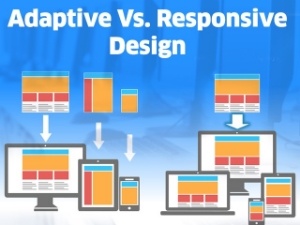In a rapidly growing mobile age, businesses need to ensure that their Website translates to whatever device their consumers are using. Companies often design mobile sites considering factors like screen size, device, browser and OS. Could your business benefit from a more contextually relevant experience?
User interactions translate into sales, so why wouldn’t you treat it as an opportunity? Both responsive and adaptive Web design, keep in mind the user experience across different devices for features like resolutions, control mechanisms and usage contexts.
Adaptive design identifies the device and other features to ensure the appropriate structures communicate correctly with the layout. While responsive design works on the principle of flexibility, one Website that will work seamlessly across any device. Let’s examine other pros and cons of each form of Website design.
The Case for Adaptive Website Design
- It utilizes many components of progressive enhancement (PE) as a way to define the design methods that focus on the user and not the browser. By deploying a predefined set of layout sizes based on the size of the device screen, CSS and JavaScript, the sites are able to adapt to each different device.
- Adaptive sites are created in several different versions beforehand, and then the correct version of the site is sent to the user. The design is significantly more complex and expensive, but it’s the best way to reach the broadest mobile audience.
- Major benefits of Adaptive Web Design include the load performance time and overall user experience. The adaptive delivery transfers only the assets necessary for the device the users are using. It optimizes images based on the resolution and the size of the user’s device. This provides the flexibility to have a high, medium and low experience catered to each location and connection.
- If you’re looking for a highly interactive site that works for any user who visits your site, then you need to create an adaptive design. It important to keep in mind that adaptive design is costly and needs more upkeep.
The Case for Responsive Website Design
- The layout decision for responsive design is determined on the client side. The choice is made according to the user’s browser, so the same file is sent to each customer, but depending on the device, parts of the file may be hidden from the viewer.
- Responsive websites work well for sites that have a lot of content and minimal expectation for user intent or device consideration. The approach is aimed to provide an optimal viewing experience, i.e. easy to read and navigate.
- A significant benefit of a responsive design approach is that it’s inexpensive compared to adaptive design. It uses a single codebase to serve both mobile and desktop users. Your business can have a single responsive site to accommodate both mobile and desktop users. For developers it’s beneficial because it means they’re only responsible for one website. It also unifies work like analytics, strategy and deployment.
- As we stated, responsive design is one website that communicates with any device, so it can be more challenging to create and it requires more attention to detail with the sites code to ensure that it’s functioning properly.
No matter what method you choose to deploy, your users want your sites to load quickly and effectively. They need to be able to navigate your website whether they’re viewing it from an iPad or a desktop. It’s all about measuring the priorities for your users and deciding which approach would work best.
Aside from deciding which design is best for your website redesign, make sure you have these 25 MUST-HAVE's to drive leads, sales and traffic. Download our free ebook to find out what they are!
